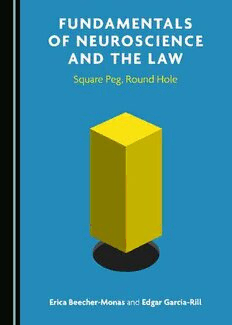
Fundamentals of Neuroscience and the Law: Square Peg, Round Hole PDF
Preview Fundamentals of Neuroscience and the Law: Square Peg, Round Hole
Fundamentals of Neuroscience and the Law Fundamentals of Neuroscience and the Law : Square Peg, Round Hole By Erica Beecher-Monas and Edgar Garcia-Rill Fundamentals of Neuroscience and the Law: Square Peg, Round Hole By Erica Beecher-Monas and Edgar Garcia-Rill This book first published 2020 Cambridge Scholars Publishing Lady Stephenson Library, Newcastle upon Tyne, NE6 2PA, UK British Library Cataloguing in Publication Data A catalogue record for this book is available from the British Library Copyright © 2020 by Erica Beecher-Monas and Edgar Garcia-Rill All rights for this book reserved. No part of this book may be reproduced, stored in a retrieval system, or transmitted, in any form or by any means, electronic, mechanical, photocopying, recording or otherwise, without the prior permission of the copyright owner. ISBN (10): 1-5275-4171-1 ISBN (13): 978-1-5275-4171-9 Dedication Often times posthumously rendered accomplishments are exaggerated. This is not true for Erica Beecher-Monas. In her case, the perseverance, honesty, and grace with which she lived her personal life was applied in equal measure to her work. Since our collaboration began in 1998, her incisive, original, and substantive ideas on what the law should do for society have been at the forefront of her efforts. This book is a tribute to the productive accomplishments over that time that resulted in a number of important contributions. Through a protracted illness, she worked doggedly on this book that stands as a legacy to a unique law professor. Just as in neuroscience, few in legal academia realize how removed their daily endeavors are estranged from everyday life. The consequences of such an estrangement for the well-being of society are significant. It is to the more informed decision-making, the more humane policy drafting, and the more relevant law enactment, that Erica devoted her life. And she did so with the same love and commitment she had for her children and grandchildren, to whom this book is dedicated. TABLE OF CONTENTS Acknowledgments ........................................................................................................... x Foreword........................................................................................................................... xi Preface ..............................................................................................................................x iii Chapter One ...................................................................................................................... 1 Time to Shift that Paradigm: Law’s Out-Dated Views on Human Behavior 1. Historical Roots of Law 2. Human Nature in the Nineteenth Century 3. Law’s Current Vision 4. Who are We? 5. What Happens When the Survival System is Disrupted? 6. How Should Neuroscience Help Us to Build a New Paradigm for Law 7. Consequences Chapter Two ...................................................................................................................2 9 Gatekeeping Mental State Testimony 1. The Required Analysis 2. How does Science Work? 3. What would Popper say about Mental State Testimony? 4. Mental Capacity in the Courts 5. Conclusion Chapter Three ................................................................................................................ 57 Basic Concepts: Lost in Translation 1. Introduction 2. Gatekeeping: the meaning of relevance 3. Statistics in Context: The Problem of atomistic Admissibility 4. Statistical Misunderstandings in Criminal Cases 5. Possible Solutions 6. Educating Bench and Bar About Statistical Inference Drawing 7. Conclusion viii Table of Contents Chapter Four ................................................................................................................ 110 Overselling Images: fMRI and the Search for Truth [Originally published as Beecher-Monas, E. and Garcia-Rill, E. 2015 Over-Selling Images: fMRI and the search for truth. John Marshall Law Review 48: 651-692.] 1. Introduction 2. How Lie Detectors Work 3. The Method 4. Can Arousal Issues be Disassociated From Signals Related to Lie Versus Truth? 5. How are the fMRI Images Generated? Are They “Preprocessed”? 6. What is Deception? 7. Criminal Cases: Linking Brain and Behavior 8. Civil Cases 9. If Not fMRI, Is There a Better Thought Detector? 10. Conclusion Chapter Five ................................................................................................................. 160 Danger at the Edge of Chaos: Predicting Violent Behavior in a Post- Daubert World [Originally published as Beecher-Monas, E. and Garcia-Rill, E. 2003 Danger at the edge of chaos: future dangerousness and predicting violent behavior. Cardozo Law Review 24: 1845-1901.] 1. Introduction 2. Future Dangerousness Testimony in the Courts 3. Daubert and Expert Predictions of Violence 4. Explaining and Predicting Violence 5. Assessing Scientific Validity of Actuarial Predictions 6. Cognitive Psychology: Why Actuarial Instruments May Assist the Jury 7. Conclusion Chapter Six ................................................................................................................... 229 Genetic Predictions of Future Dangerousness: Is There a Blueprint for Violence? [Originally published as Beecher-Monas, E. and Garcia-Rill, E. 2006 Genetic Predictions of Future Dangerousness: Is there a Blueprint for Violence? Law & Contemp. Probs. 69: 301-341.] 1. Introduction 2. Future Dangerousness in the Courts 3. Data on Violence and Sexual Violence Fundamentals of Neuroscience and the Law ix 4. Behavioral Genetics and Future Dangerousness 5. Conclusion Chapter Seven ............................................................................................................. 288 Actus Reus, Mens Rea and Brain Science: What Do Volition and Intent Really Mean? [Originally published as Beecher-Monas, E. and Garcia-Rill, E. 2017 Actus Reus, Mens Rea and Brain Science: What do volition and intent really mean? Kentucky Law Journal, 106: 265-314.] 1. Introduction 2. The Neural Underpinnings of Volition and Intent 3. Free Will and Consciousness 4. Volition, Intent, and Choice in Court 5. Theories of Criminal Law 6. What Do Actus Reus and Mens Rea Mean? 7. How Neuroscience Can Help 8. Unpacking the Meaning of Volition, Choice and Intent 9. Conclusion Chapter Eight ............................................................................................................... 347 Gatekeeping Stress: The Science and Admissibility of Post- Traumatic Stress Disorder Testimony [Originally published as Garcia-Rill, E. and Beecher-Monas, E. 2001 Gatekeeping stress: the science and admissibility of post-traumatic stress disorder. UALR Law Review 24: 9-40.] 1. Introduction 2. The Physiology of Stress 3. A Framework for Admission of PTSD Evidence in Civil and Criminal Cases 4. Conclusion Chapter Nine ................................................................................................................ 383 The Future of Neuroscience and the Law 1. Introduction 2. Famous Neuroscientific Theories 3. Famous Techniques 4. The Revolution 5. Relevance to the Law Index................................................................................................................................ 396
